
24/7 Insights
- Wall Street expectations for where Eli Lilly and Co. (NYSE: LLY) stock is headed vary considerably.
- The pharmaceutical stock faces risks, including becoming overbought, but some analysts still have faith.
Eli Lilly and Co. (NYSE: LLY) stock has been red hot over the past couple of years, far outpacing the broader markets. This is due in part to its rich product line and pipeline, lately driven by its Zepbound weight-loss treatment and the prospects for its just-approved Alzheimer’s treatment. Is there more upside to come, or is the stock overbought? Shareholders and would-be investors must be wondering where the stock could be headed, at least for the next year.
Why Invest in Eli Lilly?

The company is known for Prozac, Cialis, Cymbalta, and many more major pharmaceuticals. It is a Fortune 500 company and on the Forbes list of America’s Best Employers. In the past 20 years, Eli Lilly stock is up nearly 1,200%. It was last seen trading near an all-time high of almost $917 per share, due in part to its emerging blockbusters in diabetes and obesity treatments. So, the question for investors is whether there is still time to ride that train or the shares have become overbought. How much further will the share price go in the coming year, and beyond?
Eli Lilly, the Company

The company discovers, develops, and markets human pharmaceuticals worldwide. The company offers Humalog insulin lispro for diabetes; Jardiance, Mounjaro, and Trulicity for diabetes; and Zepbound for obesity. Its oncology products include Alimta, Cyramza, Erbitux, Jaypirca, Retevmo, Tyvyt, and Verzenio. In addition, Eli Lilly offers the following:
- Olumiant for rheumatoid arthritis, atopic dermatitis, severe alopecia areata, and COVID-19
- Taltz for plaque psoriasis, psoriatic arthritis, ankylosing spondylitis, and non-radiographic axial spondylarthritis
- Omvoh for ulcerative colitis
- Cymbalta for depressive disorder, diabetic peripheral neuropathic pain, generalized anxiety disorder, fibromyalgia, and chronic musculoskeletal pain
- Ebglyss for severe atopic dermatitis
- Emgality for migraine prevention and episodic cluster headache
- Cialis for erectile dysfunction and benign prostatic hyperplasia
- Forteo for osteoporosis
Eli Lilly is headquartered in Indianapolis. It was founded in 1876, and its stock first went public in 1952. Competitors include AbbVie Inc. (NYSE: ABBV), Bristol-Myers Squibb Co. (NYSE: BMY), Merck & Co. Inc. (NYSE: MRK), and Pfizer Inc. (NYSE: PFE).
The long-awaited FDA approval of Eli Lilly’s donanemab Alzheimer’s disease treatment is good news for the company. The company also recently announced that it is partnering with OpenAI to spearhead its drug discovery efforts. However, note that the chief financial officer resigned last month. There is also speculation about whether the stock will split soon.
Ten Reasons to Buy Eli Lilly Stock Now
Eli Lilly, the Stock

The share price is more than 93% higher than a year ago and recently hit an all-time high of $916.83. The S&P 500 is up over 23% year over year. Note that the stock has run well past the analysts’ consensus price target.
Out of 22 analysts who cover the stock, 13 recommend buying shares, four of them with Strong Buy ratings. BofA Securities, Cantor Fitzgerald, and Truist Securities recently reiterated Buy-equivalent ratings. About 84% of shares are held by institutional investors, including at BlackRock, Vanguard, and PNC Financial. Eli Lilly is Jim Cramer’s top weight loss pick. It is also a top growth stock pick of billionaire Ray Dalio. Note that the Lilly Endowment, a beneficial owner, parted with more than a million shares in June.
Wall Street expectations for where the stock goes in the next 52 weeks vary. While at least one analyst anticipates notable further upside, the lowest price target indicates a much bigger drop in the share price. Moreover, the consensus projection signals an about 3% pullback.
| Low target | $600.00 | −33.8% |
| Mean target | $878.70 | −3.1% |
| High target | $1,041 | 14.8% |
Eli Lilly does face some risks. The weight-loss segment may soon become crowded, placing pressure on Eli Lilly’s market share. There is also the chance that drugs in the pipeline fail to get FDA approval, or lawmakers ramp up the pressure on pharmaceutical companies to lower prices. Should the company become involved in controversy again, as it did in 2018 over insulin pricing, that could weigh on shares as well.
While the outlook may not be entirely rosy, at least one analyst anticipates plenty more upside in the coming year. Plus, there has been some speculation that Eli Lilly could have a trillion-dollar market cap by the end of the decade.
∴
Thank you for reading! Have some feedback for us?
Contact the 24/7 Wall St. editorial team.





